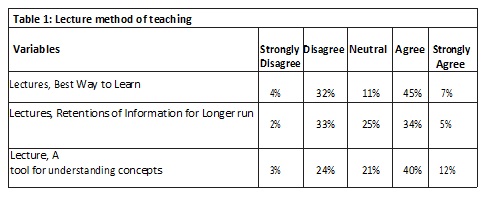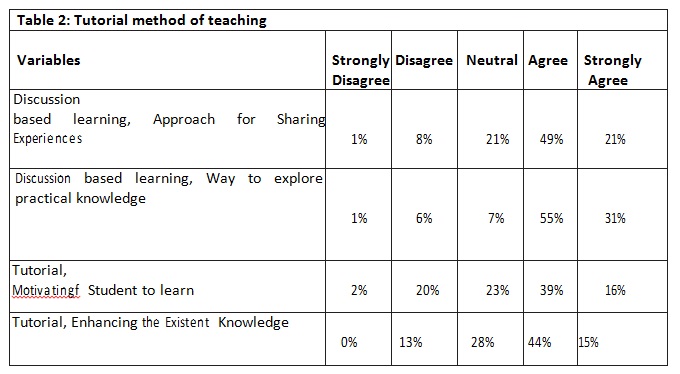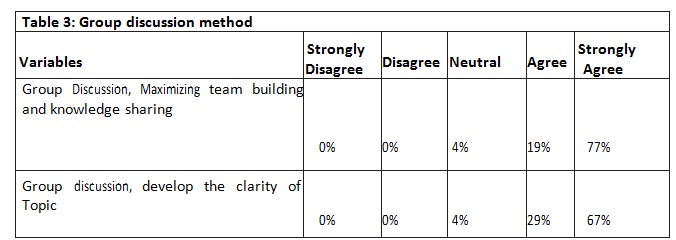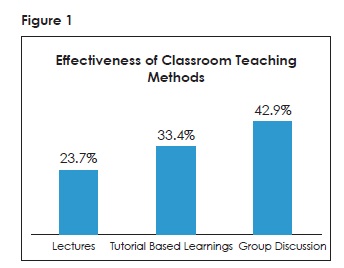ABSTRACT
OBJECTIVES
To analyze and evaluate the level of satisfaction among physical therapy students on different modes of teaching in Karachi based Universities.
METHODS
This is a cross sectional descriptive study. A total number of 150 physical therapy students of final year were selected as a sample from different universities of Karachi through simple random sampling technique. A questionnaire was used as an instrument. Frequency distribution was used to assess the results of study in accordance with an objective of the research.
RESULTS
The result shows that, group discussion is significantly effective (42.9%) to understand the content. However, tutorial is less favorable (33.4%) methodology which is used in university for final year students. Hence, they are not attracted towards lecture series (23.7%) in university due to less remembrance of content.
CONCLUSION
Our study concluded that, satisfaction of students in university is directly associated with the discussed effective methods of teaching. Group discussion and tutorial teaching methodology are more attractive to students for building a strong understanding. However, educational fares, galas and problem-based learning methods are also effective and valued d technique to build better understanding for students of physical therapy.
KEY WORDS
Undergraduate, Teaching Methods, Physiotherapy, University, Student Satisfaction, Karachi
Dr. Shahnila Naveed
Senior Lecturer
Ziauddin College of physical therapy
Ziauddin University
Akbar Lakhani
Senior HR Executive
Department of Human Resources
Aga Khan University Hospital,
[Naveed S, Lakhani A. Analysis of the Satisfaction level among Physical Therapy Students on Different Modes of Teaching. Pak. j. rehabil. 2014;3(1):34-38]
INTRODUCTION
Physiotherapy is an allied health care profession in the field of medical sciences. Its practical implications involve direct interactions with patients and a clear understanding of condition of patient with proper diagnosis remains the fundamental objective of the profession. During academic tenure, students need to have a clear understanding of what is being taught to them and how these things will proceed further; just passing on information can never accomplish the purpose. Therefore, it is important to know the most effective way through which students understand what is being taught to them. For this reason, feedback of every student is highly regarded as the most effective tool to evaluate different teaching methods1-3. Through student feedback, teachers can evaluate different teaching methods and techniques to deliver the medical content and find out the most effective method to share their knowledge and information which will be beneficial for students and can provide high-quality impact on patients as well2,4-6.
There are different teaching methods used in traditional and modern era to transfer information to students that include: lecture series, group discussions, and tutorials-based learning7-9. Moreover, with the passage of time, reviewing and assessing teaching methodology has become necessary in order to modify and improvise teaching.
Lecture is the most traditional mean of teaching that has often regarded as a teacher-centered approach, where the teacher conveys the information of the content, but perhaps with minimal students’ participation thus, indulging students in a passive role and interaction6,10-12.
Group discussions help to determine whether students have certain skills, knowledge and ability to perform in the learning environment along with team work, leadership skills, communication skills, decision making ability to name a few4,10,13.
Tutorial is another learning method and technique to transfer information. It is considered as a more interactive mean of learning which involves and conveys the content through real life examples to transfer contextual and textual knowledge8,14,15. In university, somehow it is depended on faculty that, how are they treating students and what the type of content being delivered at the level of undergraduate teaching. The methods are dependent upon the capability of professors and by the way faculty wish to deliver. Usually, not everyone has a command over each and every method, as some are more charismatic and innovative, so they go for other teaching methodology. If in fact, they are good at verbal communication, it helps them to deliver the content in the class with ease. Sometimes, their expertise of knowledge and way of delivering the lecture depend on the moods of students and lecturer. If the environment is not good to deliver the content whatever the faculty has planned, then the concept would not be delivered. Similarly, at the level of undergraduate teaching, faculty should focus more towards the concept through many ways and they are inventing many other methodologies according to the strength of students and faculty as well. Books are the good source to enhance the knowledge but if the books are only full of text then student are not attracting towards it. Similarly, if teachers are not preparing well according to the standard of students and they just give a long talk in front of huge class, then the attention level of student decreases, because in the modern world these contents are easily available on internet. In fact, they have a good practice exercise in it. Some of the university faculty adopts the same technique that the internet content writer has applied; they are adopting the same kind of activity for undergraduate student and clearing their concept through these activities so that students are more attracted toward what they are delivering. However, in undergraduate level universities focus on many other teaching methodologies to engage the students with study in order to build proper concept according to the standards13,16,17.
To keep students motivated and interacted during lecture, it is important to select the most effective tool to teach them without compromising on the quality of education2,18- 20. Therefore, considering all the above modes, this study tries to find out the level of satisfaction among physical therapy students on different modes of teaching, in Karachi based universities, to build the better understanding of lecture.
MATERIAL AND METHODS
A cross sectional study was conducted in Karachi, Pakistan, at different physical therapy colleges in order to analyze and evaluate the satisfaction level of physical therapy students on different modes of teaching, that are most commonly used in undergraduate degree program for students. It was a quantitative cross-sectional descriptive approach, having total sample size of 150 students selected through probability and simple random sampling techniques.
Inclusion/Exclusion Criteria
The students in the final year of their respective programs in different Karachi based physical therapy universities were included in the study. While other than final year and Karachi based universities were excluded from the study.
Ethical Consideration
Duration of the conducted research was 1 year. Data was collected by taking consent and permission from the heads of selected physical therapy colleges and universities. Consents were also taken from students after explaining the objectives of the study.
A self-administered close-ended questionnaire on likert scale was distributed among 150 physical therapy students to analyze their satisfaction level regarding different modes of teaching methods used in class of undergraduate. The questionnaire assessed the satisfaction level of students and different teaching methods that includes: lecture series, small group discussion, and tutorial teaching methods. Data entry and analysis was done on SPSS version 20.
RESULTS
In our study, we examine the teaching methodology that is more effective and its impact on student satisfaction in undergraduate level of physical therapy colleges.

Table 1 exhibits that, lectures are the best way to learn. 45% students agree that the lecture-based series is much effective way to learn the content at undergraduate level. However, 32% students disagree and consider that lectures are not effective as a learning methodology. When asked about the content retention of information for a long period of time through lecture series, 34% students agree that lectures are good to retain the content for long run furthermore, 33% students disagree that retention of information is possible through lectures. Regarding the understanding of concept through lecture series, 40% students agree that lecture series is good to build the better understanding of content and 12% of students strongly agree to it. However, 24% students said that, the lecture series are not that much effective to understand and build the concepts.

Table 2 explains that, through discussion-based learning student can share the experiences and 49% of students agree with it as it is an effective tool to share experience among the students and 21% strongly agree for the same. Then next best way to explore the practical knowledge is through discussion-based learning. According to observation, 55% of students agree that discussion-based learning is an efficient way to explore the practical knowledge at undergraduate level of study. As tutorial is a motivating tool to learn the content for students. 39% students agree that, it is a good and effective tool to learn however, 23% students have neutral impact on learning through tutorial. As tutorial is an effective tool at enhancing the existing knowledge about the content of undergraduate study. 44% of students agree that, it is much effective tool at enhancing the existing knowledge however, 28% students show neutral response of tutorial on enhancement.

Table 3 reflects that; group discussion is as good as maximizing team building and knowledge sharing. 77% of students strongly agree, as it is a good way to build team work and knowledge sharing environment among students at undergraduate level. Only 4% of the students gave neutral response to this and no student disagreed to this concept. Likewise, group discussion is developing the clarity about the topic as it is mainly focusing at knowledge sharing. 67% of the students strongly agree that, group discussion has a positive impact on clarity of topic amongst students and no student disagreed to it.

Table 4 highlights the problem-based group discussions to analyze the real situation to measure in practical life, 55% of students agreed that, it creates a high impact on visualizing the real situation to measure actual problems. 14% of students were neutral to this, whereas, none of the students disagreed to the question.

Table 5 clearly identifies the association between classroom teaching methods and student satisfaction. 53% of students agree that, classroom teaching methodology is highly associated and linked with the student satisfaction at undergraduate level, however, 43% of students are strongly agreed for the same, and none of the student disagree to this question.

Table 6 highlights some other modes of teaching at undergraduate level to attract students towards learning, includes: educational fares and gala, that is organized by the institutions, 51.3% of students strongly agreed that, it is attractive approach towards learning. Furthermore, 40.7% of students are also in the favor of these modes whereas, only 1% of the students disagreed with this idea.

However, this study highlighted the percentages of effectiveness of selected classroom techniques that is, mostly associated with the university level students in physical therapy colleges as shown in figure 1. As indicated by the above figure, group discussion is the most effective and attractive mode of teaching among the students. The data was collected and analyzed through questionnaire and found that, all the universities have a common methodology to deliver content to undergraduate students. The results show that, students suggest lecture-based teaching method helps to understand the contact of curriculum being an effective way to deliver the series of content on a timely manner. In lecture-based methodology, students are commonly used to have a good understanding through the traditional teaching methods to interact with the faculty. However, in observation, students highlighted that the tutorial-based discussion approach is more effective to understand and building a concrete concept of study that is more focused on sharing experiences amongst students and faculty. Through these teaching methods, students get the practical and simulated approaches in teaching that helps one-on-one interaction with the course facilitator to discuss any query regarding the content. Students are more involved during group discussion as they are thinking out of the box with some creativity and innovation to grasp the concept more frequently. Apparently, students like to have group discussion that helps student to work together to maximize the learning of each other. Also, the problem-based group discussion helps students to evaluate the situation.
DISCUSSION
Physiotherapy is a subject which has to be understood thoroughly in order to treat the patients. Lectures provide sufficient information to students, but it is a faculty centered approach and involves a one-way flow of information2,7,10,11,14.
As per our research, around 23.7% of students are satisfied with lecture-based teaching. According to the research, conducted by the department of pharmacology at Saveetha Medical College, India that 26% of students are satisfied with lecture-based approach and hence, considering that lack of interaction is one of the major limitations of lecture-based teaching approach. Since, students having the copies of these lectures, they will supposedly consider reading them instead of paying attention in the class that offer little or no interaction or participation14. As per the study conducted at Nishtar Medical College, Multan in 2012, claimed around 71% of students were satisfied with lecture series teaching method7. Lack of discussion and queries result in students just listening to the lecture with no understanding of it; makes it an ineffective teaching method and since students have a copy of the lectures and books to refer so it makes attending such a lecture less satisfactory for the students 16,20.
In a tutorial method, students meet in groups with a tutor from their discipline to assist them1,6,18. It helps students to gain understanding of the subject, develops the ability to think, and solve problems. It further develops their interpersonal and intellectual skills such as speaking, listening, pre-thinking, and working in groups. Our study concluded that, 33.4% of students preferred tutorial method of teaching. Such a process is very beneficial for physiotherapy undergraduate students, as their profession will require them to interact with patients on a daily basis10,11,14. When compared with another study conducted at Saveetha Medical College, department of pharmacology where they found out that, 39% of students were satisfied with tutorial method 14. In a class room environment group discussion is an effective way to promote conductive learning. It helps them to think, motivates them to along with the lecture. It keeps them involved and students would not lose their focus. Such group discussions help to develop interpersonal skills as well. According to our findings, 42.9% of students preferred group discussion as the most effective and satisfying teaching method. In our study, students rated group discussion higher than tutorial and lectures-based teaching. Compared with the study conducted at department of pharmacology at Saveetha Medical College, India, 35% of students preferred group discussion style of teaching14.
There are many other teaching methods that can also be implemented in Physical Therapy Colleges at undergraduate level of students because of it reflecting greater satisfaction amongst university students1,6,20,21. Some of the concerned methods include: Problem-based learning techniques, Educational fairs and galas, and pre-content knowledge approach.
Problem-based learning allows students to learn about the topic through the experience of problem solving, but it requires more extensive resources to operate such approach along with the experience 21-23. As per the review conducted on the effectiveness of problem-based learning, it was concluded that, it improves knowledge but not to the extent as expected given the resources required for this approach10,15. Furthermore, several international universities have organized educational gala and fairs for undergraduate and post-graduate students to motivate them by providing a proper pathway to deliver knowledge through real life examples and practical approaches. It is a very effective way to demonstrate content in front of all to see how actually it works in a real scenario2,5,13,24,25. Our study also found that, 51% of students strongly agreed that education fares and gala are an attractive approach towards learning. These methods are also effective in teaching to satisfy the needs of in understanding the content at all university levels. Somehow, it depends on faculty that how they are mentoring students and what type of contents being delivered at all levels of undergraduate teaching.
CONCLUSION
After staunch efforts, self-assured the conclusion was drawn that students of College of Physical Therapy at Karachi, about level of satisfaction on different teaching methods – group discussion was effective and satisfactory than other methodologies. In this study, three methodologies were discussed, such as; lecture teaching method, tutorial learning method and group discussion method. It shows that, to gain knowledge, group discussion has an integral role than tutorials and lectures.
REFERENCES
- Al-Maghraby MA, Al-shami AM. Learning style and teaching method preferences of Saudi students of physical therapy. J Family Community Med. 2013;20(3):192-7 doi:10.4103/2230-8229.122017.
- Colthorpe K, Ernst H. The efficacy of interactive lecturing for students with diverse science backgrounds. Adv Physiol Educ Advances. 2007;31:41-44 doi: 10.1152/advan.00107.2006.
- Graham CL. Conceptual learning processes of physical therapy students Phys Ther. 1996;76(8):856-65.
- Carpenter JM. Effective teaching methods for large classes. JFCSE 2006;24(2):13-23.
- Downie RS, Calmen KC. Practical problems in the teaching of ethics to medical students. J Med Ethics. 1987;13(3):153-6.
- Olmos G, Ruiz-Torres MP, Calleros L, Cortés MA, de Frutos S, Ospina R, et al. Creating and using educational resources to improve practical teaching in the Human Physiology subject on the bachelor’s degree course in Physical Activity and Sports Sciences. Assessment of results. RUSC. 2014;11(1):108-27.
- Rafique S, Rafique H. Student’s feedback on teaching and assessment at Nishtar Medical College,
- J Pak Med Assoc. 2013;63(9):1205-9.
- Jarahi L, Najafi MN. Evaluation of teaching through lecture with new methods of student-centered teaching in medical students. FMEJ. 2013;3(4):6-11.
- Deggs DM, Machtmes KL, Johnson E. The significance of teaching perspectives among academic CTMS. 2008;4(8):1-7.
- Colliver JA. Effectiveness of Problem-based Learning Curricula: Research and Theory Acad Med. 2000;75(3):259-66.
- Branch WTJr, Paranjape A. Feedback and Reflection: Teaching Methods for Clinical Settings. Acad Med. 2002;77(12):1185-8.
- Barrett KR, Bower BL, Donovan NC. Teaching styles of community college instructors. Am J Distance Educ. 2007;21(1):37-49.
- Shapiro JF. Teaching Empathy to First Year Medical Students: Evaluation of an Elective Literature and Medicine Course. Health Educ J. 2004;17(01):73-84.
- [Thirunavukkarasu J, Latha K, Babu CS, Tharani CB. A study on effectiveness of different teaching methodology in pharmacology for under graduate students. Asian J Exp Biol Sci. 2011;2(3):487-92.
- Kirschner PA, Sweller J, Clark RE. Why minimal guidance during instruction does not work: An analysis of the failure of constructivist, discovery, problem-based, experiential, and inquiry-based teaching. Edu Psychol. 2010;41(2):75-86.
- Savoy A, Proctor RW, Salvendy G. Information retention from PowerPoint and traditional lectures. Comput Educ. 2009;52:858-67.
- Mountford H, Jones S, Tucker B. Learning styles of entry-level physiotherapy students. Adv Physiother. 2006;8:128-36.
- Mishra H, Kumar V, Modi PK. Comparison of different teaching methodologies in a Medical college in North India. IJBAMR. 2013;2(6):464-9.
- Jaykaran, Chavda N, Yadav P. Kantharia ND. Intern doctors’ feedback on teaching methodologies in pharmacology. J Pharmacol Pharmacother. 2010;1(2):114-116.
- Riaz H, Khan A, Malik AN. Learning style preferences of undergraduate physical therapy students: A cross sectional study. Interdiscip J Contemp Res Bus. 2012;4:191.
- Ted B, Tessa C, Glenys F. Learning style preferences of occupational therapy, physiotherapy and speech pathology student: a comparative study. Internet j allied health sci pract. 2008;6(3):1-12.
- Nandi PL, Chan JN, Chan CP, Chan P, Chan LP. Undergraduate medical education: comparison of problem-based learning and conventional teaching. Hong Kong Med J. 2000;6(3):301-6.
- Arthurs JB. A juggling act in the classroom: Managing different learning styles. Teach Learn Nurs. 2007;2(1):2-7.
- Victoroff KZ, Hogan S. Students’ perceptions of effective learning experiences in dental school: a qualitative study using a critical incident technique. J Dental Edu. 2006;70(2):124-32.
- Jaafari P, Ghourchian N, Behboodian J, Shahidi N. Developing a structural model for the relationship between self–efficiency, competencies and organizational commitment of faculty with their teaching. Quarterly Journal of Research and Planning in Higher Education. 2012;18(2):61-82 .
